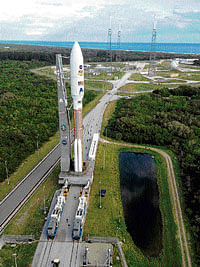Nasa's super-size Mars rover on way to red planet

It will take eight and half months for Curiosity to reach Mars following a journey of 354 million miles.
An unmanned Atlas V rocket hoisted the rover, officially known as Mars Science Laboratory, into a cloudy late morning sky. A Mars frenzy gripped the launch site, with more than 13,000 guests jamming the space centre for Nasa’s first launch to Earth’s next-door neighbour in four years, and the first send-off of a Martian rover in eight years.
Nasa astrobiologist Pan Conrad, whose carbon compound-seeking instrument is on the rover, had a shirt custom made for the occasion. Her bright blue, short-sleeve blouse was emblazoned with rockets, planets and the words, “Next stop Mars!”
The 1-ton Curiosity — as large as a car — is a mobile, nuclear-powered laboratory holding 10 science instruments that will sample Martian soil and rocks, and analyse them right on the spot. There’s a drill as well as a stone-zapping laser machine.
Its “really a rover on steroids,” said Nasa’s Colleen Hartman, assistant associate administrator for science. “Its an order of magnitude more capable than anything we have ever launched to any planet in the solar system.”
The primary goal of the $2.5 billion mission is to see whether cold, dry, barren Mars might have been hospitable for microbial life once upon a time — or might even still be conducive to life now. No actual life detectors are on board; rather, the instruments will hunt for organic compounds.
Curiosity’s 7-foot arm has a jackhammer on the end to drill into the Martian red rock, and the 7-foot mast on the rover is topped with high-definition and laser cameras. No previous Martian rover has been so sophisticated or capable.
With Mars the ultimate goal for astronauts, Nasa also will use Curiosity to measure radiation at the red planet. The rover also has a weather station on board that will provide temperature, wind and humidity readings; a computer software app with daily weather updates is planned.
The world has launched more than three dozen missions to the ever-alluring Mars, most like earth than the other solar-system planets. Yet fewer than half of those quests have succeeded. Just two weeks ago, a Russian spacecraft ended up stuck in orbit around earth, rather than en route to the Martian moon Phobos.